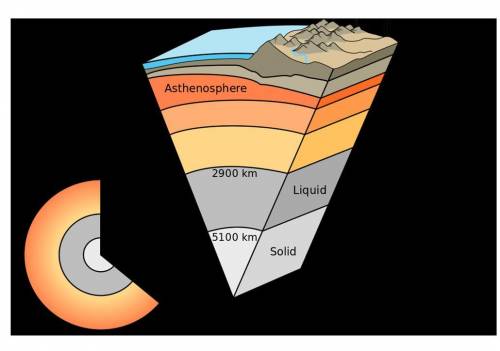Ineed !
what was the main reason scientists divided earth's core into an outer core a...

Biology, 07.01.2020 23:31 allimaycatp8qgaq
Ineed !
what was the main reason scientists divided earth's core into an outer core and an inner core?
1points
a
they have a different chemical composition.
b
they exist in different states of matter.
c
they were formed in different geological eras.
d
they are divided by a layer of partly molten material called the mesosphere.
put the following layers of the earth in order, beginning with the layer that is on the exterior of the earth and finishing with the layer that is the most interior.
2points
1
asthenosphere
2
crust
3
mantle
4
inner core
5
outer core
rock from which source would most likely contain the highest percentage of iron-bearing minerals?
1points
a
a continental margin
b
a mountain
c
a valley
d
the ocean floor
if scientists could bore through earth's interior, what change would they most likely notice as they passed from the asthenosphere to the mesosphere?
1points
a
they would detect a chemical change from solid rock to partly molten rock.
b
they would detect a change in composition from iron-rich minerals to silica-rich minerals.
c
they would detect a physical change from partly molten rock to solid rock.
d
they would detect a change in composition from magnesium-rich minerals to oxygen-rich minerals
which best describes the shape of earth's inner core?
1points
a
cylindrical
b
elliptical
c
tetrahedral
d
spherical
how did scientists determine that the outer core is a liquid?
1points
a
certain seismic waves that travel only through solids produced shadow zones in different parts of the globe.
b
scientists detected energy from certain seismic waves that travel only through liquids deep within earth.
c
scientists were able to analyze material that was recovered from drilling into the earth's core.
d
analysis of magma from deep within earth's surface showed that it was chemically different from magma in earth's mantle and crust.
which statement best explains why earth's core contains such high percentages of iron and nickel?
1points
a
centrifugal force generated by earth's rotation pulls denser minerals toward the planet's center.
b
iron and nickel are not found anywhere in earth's crust.
c
when earth was still molten, gravity pulled dense elements down to earth's center.
d
metallic elements are attracted to earth's center due to the magnetic fields it generates.
why does the amount of oceanic crust in a tectonic plate change over time?
1points
a
the weight of the continents continually presses oceanic crust into the asthenosphere.
b
erosion from continental crust continually forms new oceanic crust.
c
the amount of oceanic crust in a tectonic plate stays constant over time.
d
oceanic crust is continually recycled into the mantle and re-formed at mid-ocean ridges.
what process drives mantle convection?
1points
a
the transfer of thermal energy from earth's surface toward its core
b
the transfer of electromagnetic energy inward from earth's surface
c
the transfer of radioactive materials outward from earth's interior
d
the transfer of thermal energy from earth's core toward its surface
which statement best describes earth's core?
1points
a
the outer core is partly molten and the inner core is fully molten.
b
the outer core is solid and the inner core is liquid.
c
the entire core is solid.
d
the outer core is liquid and the inner core is solid.
which statement best explains why earth's lithosphere is broken into tectonic plates?
1points
a
shortly after earth formed, the lithosphere cooled, causing it to contract and crack.
b
the lithosphere cracks and deforms under the weight of the continents.
c
earthquakes from cracks in the lithosphere that grow larger over time, creating new plates.
d
the brittle lithosphere cracks under pressure from the moving asthenosphere.
which statement best explains why scientists cannot study earth's inner core directly?
1points
a
the magnetic fields it generates interfere with signals from instruments.
b
it consists of highly radioactive materials.
c
it is too deep inside earth to reach by drilling.
d
it transmits too few seismic waves.
what do the lithosphere and upper mantle have in common?
1points
a
convection cells within them move tectonic plates at earth's surface.
b
they are similar ages (over 4 billion years old).
c
they consist of similar ratios of silicon to iron.
d
they have similar textures (brittle).

Answers: 1


Another question on Biology

Biology, 22.06.2019 01:00
Which of the following is not a symptom of desertification? a) decrease in salt content of the soil b) lowering of the water table c) reduced surface water d) increased soil erosion e) loss of native vegetation
Answers: 1

Biology, 22.06.2019 13:20
Where is the nictitating membrane found? a. between the eyelid and the eyeball b. between the retina and the optic nerve c. between the outer and middle ear d. in the organ of corti in the middle ear
Answers: 2

Biology, 22.06.2019 14:00
Which diagram best represents the chromosomes that would be found in a two new skin cells produced as a result of this process?
Answers: 1

Biology, 22.06.2019 14:40
Both destructive and constructive, the natural event seen here, is important in destroying and creating landforms on earth. what is this event called? a) deposition b) flooding c) landslide d) sedimentation
Answers: 2
You know the right answer?
Questions

Mathematics, 29.07.2021 14:00

Mathematics, 29.07.2021 14:00


Mathematics, 29.07.2021 14:00

Mathematics, 29.07.2021 14:00

World Languages, 29.07.2021 14:00

English, 29.07.2021 14:00


French, 29.07.2021 14:00

Social Studies, 29.07.2021 14:00

Physics, 29.07.2021 14:00


Mathematics, 29.07.2021 14:00

Mathematics, 29.07.2021 14:00


English, 29.07.2021 14:00

History, 29.07.2021 14:00

Biology, 29.07.2021 14:00

Mathematics, 29.07.2021 14:00




